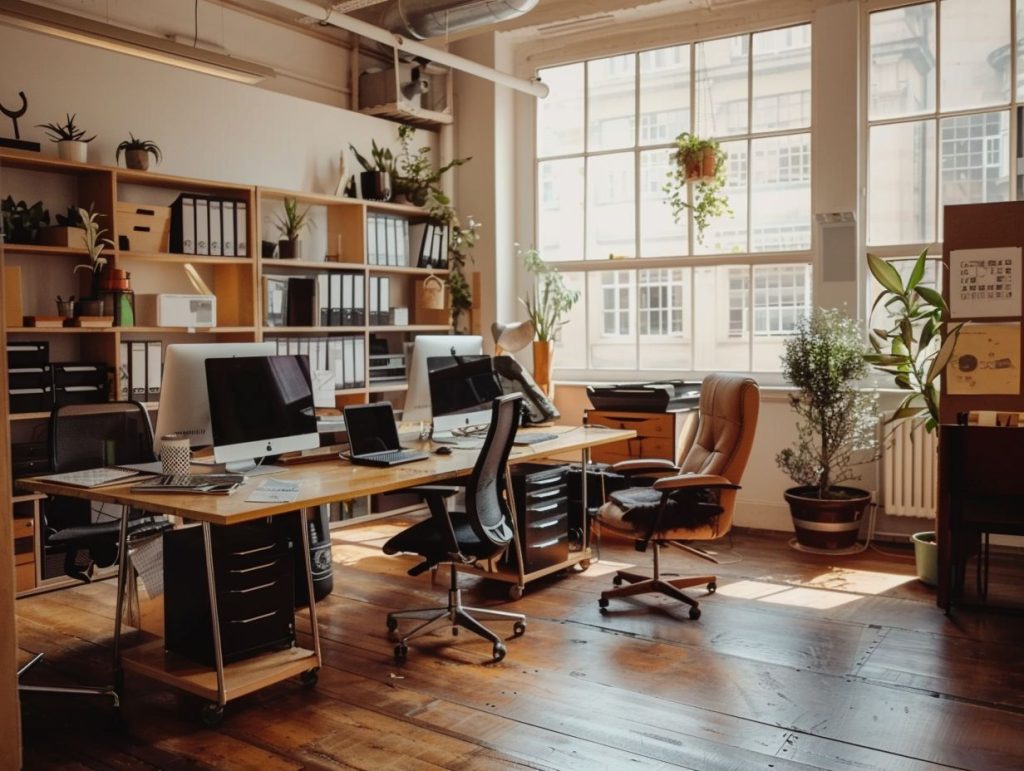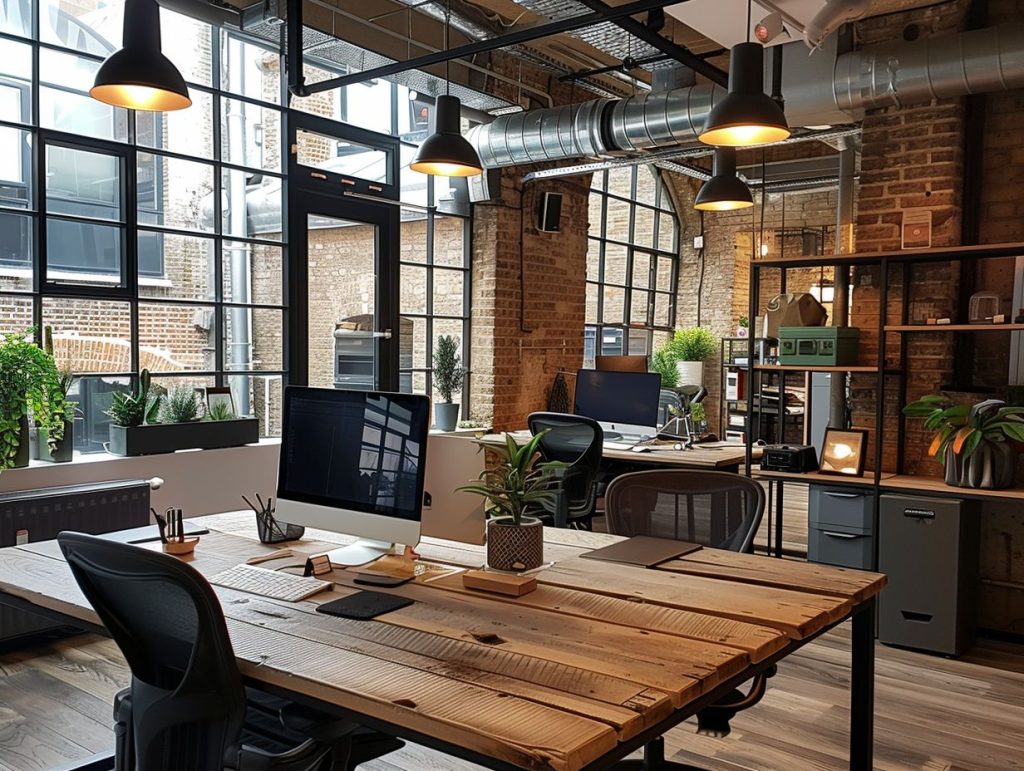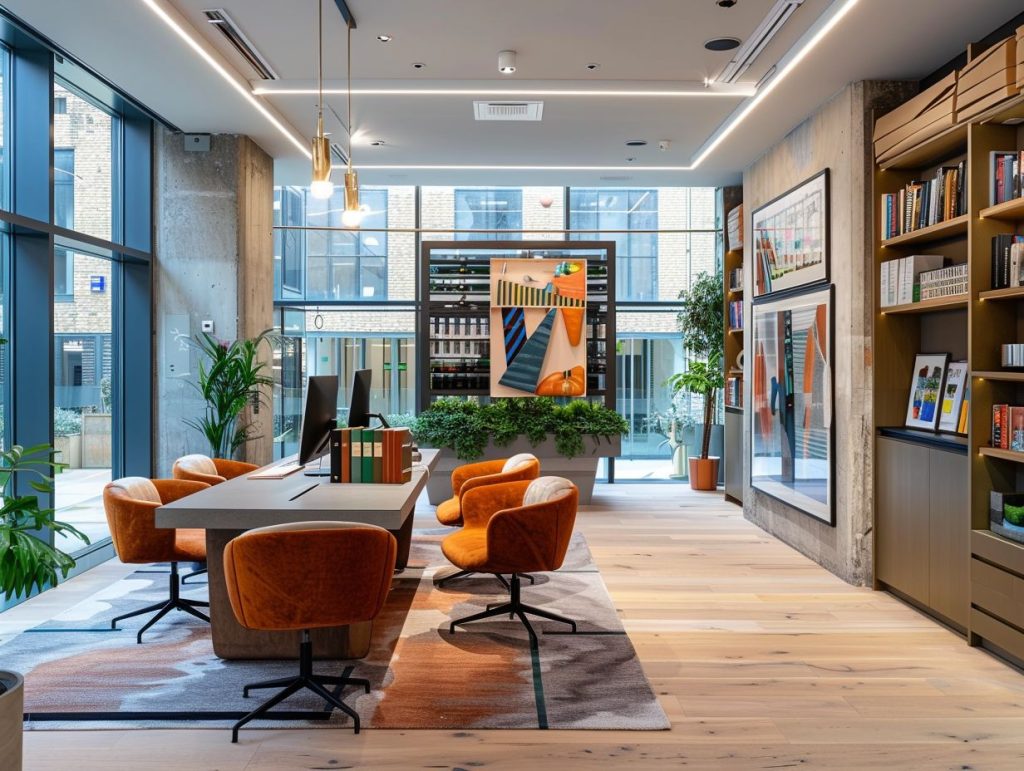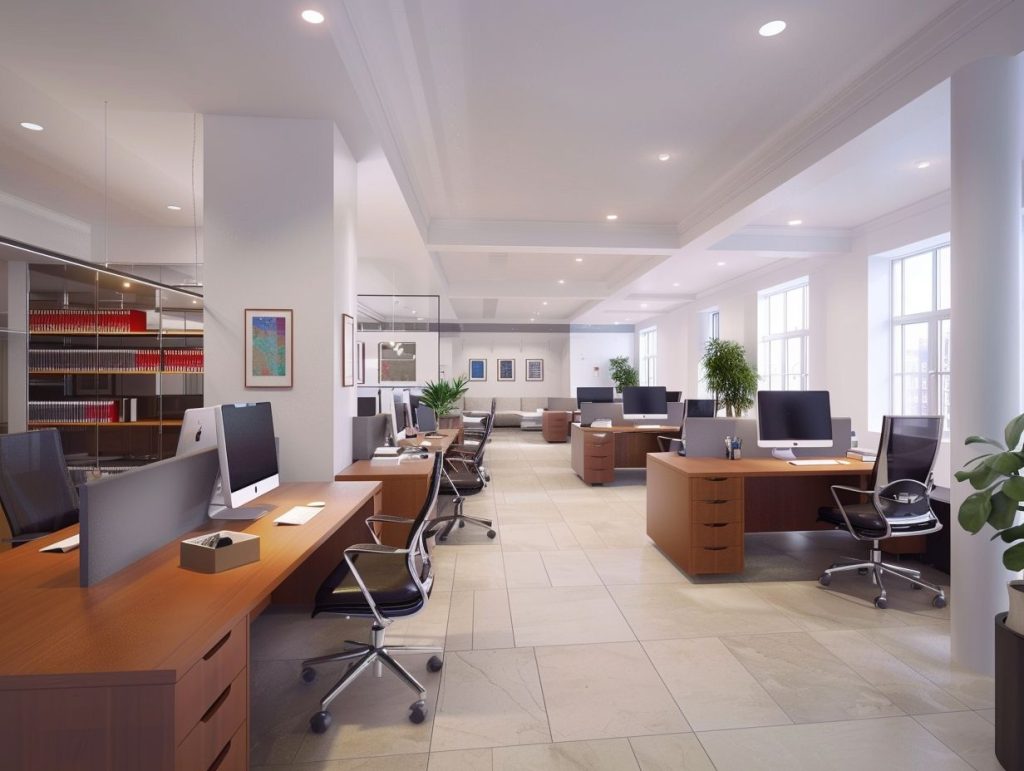Working with high-end global brands and cleaning their large corporate offices presents unique challenges, especially in high-traffic areas and during extended hours. With the constant flow of employees and visitors, ensuring a tidy environment is crucial for health, productivity, and morale.
This article explores effective strategies for tackling cleaning difficulties, from identifying problem areas to managing cleaning staff and choosing the right products. It also covers the importance of regular maintenance and deep cleaning, providing insights to keep your office sparkling clean.
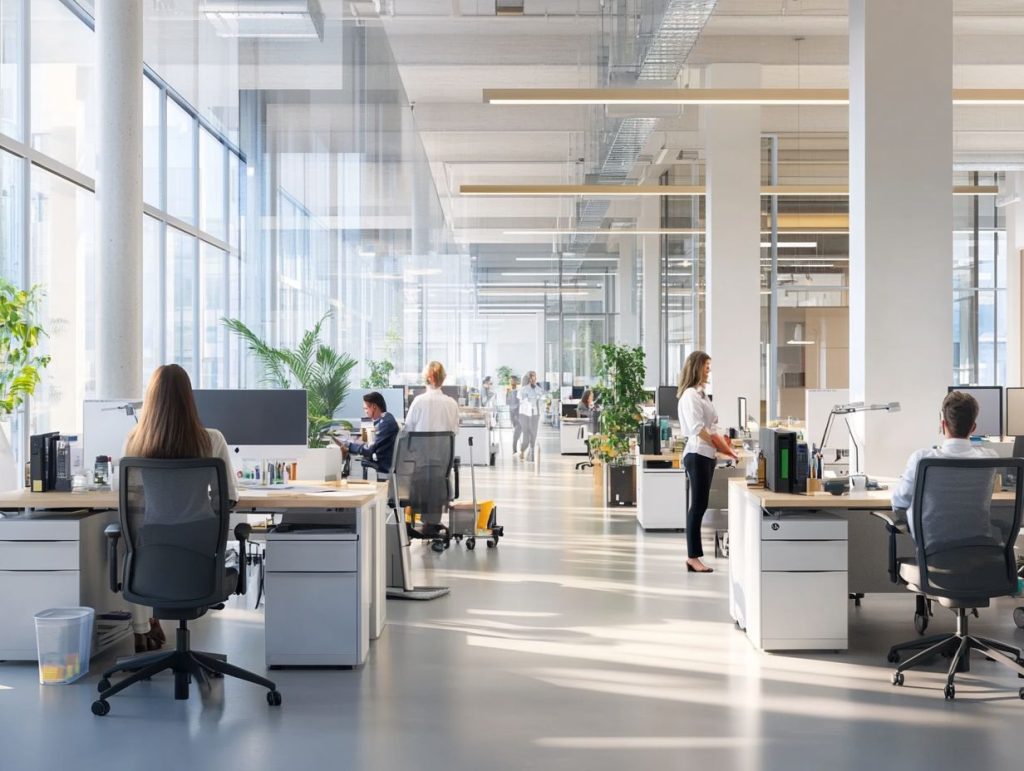
Cleaning Challenges in Large Corporate Offices
Cleaning large corporate offices presents challenges that can impact the workspace’s appearance, employee productivity, and overall sanitation. High-traffic areas, shared spaces, and a mix of hygiene standards make office maintenance a bit tricky.
To keep corporate environments clean, it is crucial to understand these challenges to develop effective cleaning strategies. Cleaning services must be efficient and mindful of sanitation practices to create a safe and pleasant working environment.
Understanding the Unique Needs of High-Traffic and Extended Hours
In corporate environments where things get pretty busy, understanding how to clean during those extended hours is key to keeping your workspace healthy. With employees bustling around, surfaces and furniture can take a beating, so consistent cleaning is crucial. Moreover, the visibility of cleaning during these hours can affect employee health and morale. It’s all about balancing thorough cleaning and minimal disruption for effective office maintenance.
To make this work, consider scheduling cleaning teams during off-peak hours. This way, you can minimise interruptions while ensuring common areas like lobbies and break rooms receive a deep clean, especially where foot traffic is heaviest. Using eco-friendly cleaning supplies boosts employee wellness and aligns with the sustainability goals that many companies champion.
And let’s not forget about using discreet cleaning methods. This ensures that employees can stay focused on their tasks without being distracted by noise or the presence of cleaning staff. Therefore, a solid cleaning strategy is essential for creating a workspace that promotes hygiene and productivity.
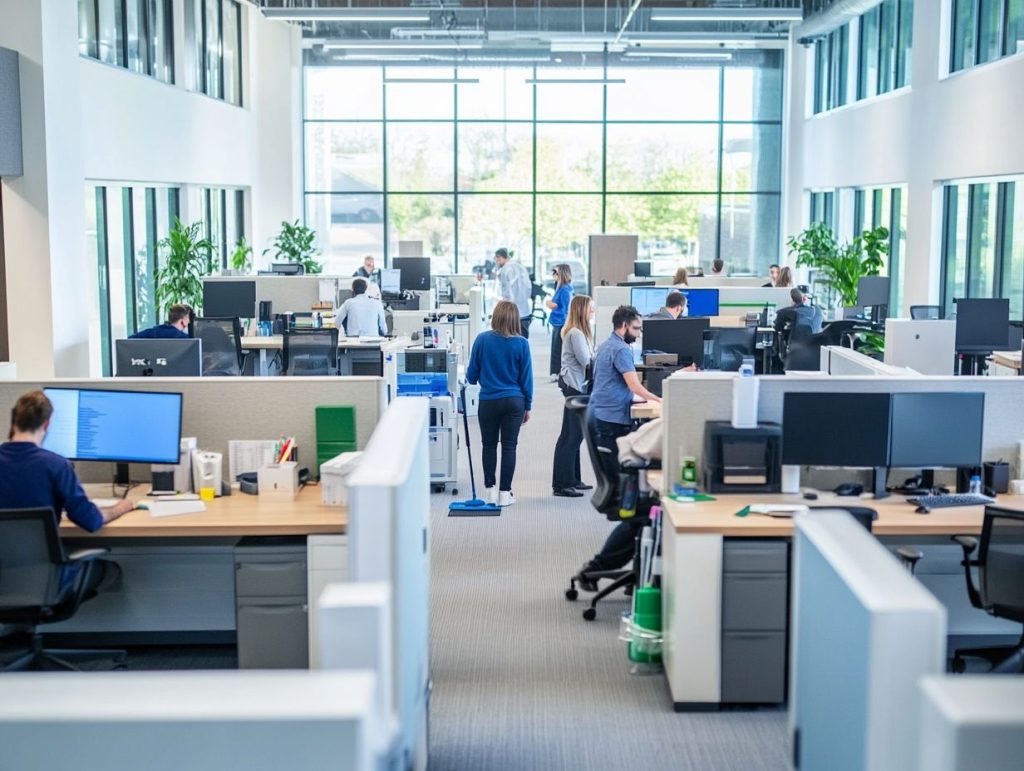
Effective Cleaning Strategies for High-Traffic Areas
Implementing effective cleaning strategies for high-traffic areas is essential for keeping corporate offices clean and hygienic. Pay attention to lobbies, break rooms, and toilets since they require frequent care to manage dust, clean surfaces, and maintain overall sanitation.
Regular waste management and toilet upkeep improve the workspace’s appearance and boost employee health and morale. By tailoring your strategies to meet these areas’ specific needs, you can create a cleaner, more inviting environment for everyone.
Identifying and Addressing Common Problem Areas
Identifying and tackling common problem areas in corporate offices boosts cleaning effectiveness and keeps employee productivity on point. High-touch surfaces, cluttered storage areas, and pesky odours often slip under the radar but can seriously affect office hygiene. When cleaning visibility is spot on, maintenance staff catch these problems early. Taking proactive steps like pest control and odour elimination can save you from more significant headaches.
When you work in a clean and organised space, your focus and motivation naturally get a lift, leading to better performance. Keeping an eye on frequently touched areas—like doorknobs, keyboards, and shared equipment—helps minimise germs, which is a win for everyone’s health. A smart approach to managing clutter can streamline operations, making it easy for everyone to find what they need quickly.
By prioritising these elements, your company can create a safer workspace and a positive atmosphere that sparks employee collaboration and creativity.
Managing Cleaning During Extended Hours
Managing cleaning during extended hours is key to keeping things tidy without disrupting daily operations in corporate offices. Implementing well-planned cleaning schedules ensures everything gets done effectively and minimises disruption to your employees’ workflows.
Adhering to safety protocols is also very important, especially with all the focus on infection control. By strategically timing cleaning tasks, you can create a healthier workspace while respecting your employees’ working hours.
Strategies for Minimising Disruptions and Maintaining Cleanliness
You’ll want to implement some strategic cleaning schedules in your corporate office to keep disruptions to a minimum while ensuring everything stays clean. By bringing in professional cleaning services and using specialised cleaning methods, you can ensure high-traffic areas are spotless without undermining employee morale or productivity. A well-organised cleaning approach doesn’t just keep your workspace looking fresh; it also creates a positive atmosphere for everyone.
Consider scheduling deep cleaning during off-peak hours or opting for eco-friendly products that reduce harmful chemical exposure. Involving the staff in the cleaning process can also foster a sense of pride in their environment, enhancing workplace satisfaction.
Professional cleaning services that use the latest technology can customise their strategies to fit your office’s unique needs, ensuring cleanliness is achieved efficiently and effectively. By focusing on these strategies, you create a workspace that supports health and hygiene while encouraging a productive and harmonious atmosphere.
Choosing the Right Cleaning Products and Equipment
When selecting cleaning products and equipment for corporate offices, it’s essential to choose wisely, especially given the different surface types. Opting for eco-friendly products keeps you in line with chemical safety standards, helps maintain a clean environment, and supports employee health.
Furthermore, choosing the right equipment—such as microfiber cloths and vacuum tools—can significantly enhance the efficiency of your cleaning processes.
Factors to Consider for Different Types of Surfaces and Environments
When choosing the right cleaning products and solutions, it’s key to understand the different surfaces and environments in corporate offices. Each type requires specific cleaning solutions for optimal care and maintenance, whether dealing with hard floors, carpets, or office furniture. Figuring out how to tackle each surface effectively can boost cleanliness and extend the life of your office assets.
Factors such as foot traffic, material types, and potential allergens are essential when selecting the right cleaning agents in corporate settings. For example, hard floors might benefit from pH-neutral cleaners that won’t cause surface damage, while carpets need specialised solutions to lift stains without ruining the fabric. Regarding furniture, you’ll want gentle, non-toxic products to protect the finishes and keep the work environment pleasant.
By carefully assessing each surface’s needs and matching them with the proper cleaning techniques, you can enhance the workspace’s aesthetics and contribute to your team’s health and productivity.
Training and Managing Cleaning Staff
Training and managing your cleaning staff is key to maintaining high cleanliness standards in corporate offices. By implementing thorough training programmes, you equip your maintenance team with the skills and knowledge they need to do their jobs effectively.
This not only boosts customer satisfaction but also keeps your workspace looking smart. Moreover, fostering a team collaboration culture can enhance quality control and improve cleaning results.
Best Practices for Maintaining a High Standard of Cleanliness
To keep your corporate office spick and span, it’s crucial to implement some best practices that promote organisation and efficiency. Cleaning checklists can help streamline routine inspections and ensure you don’t overlook any critical tasks. A consistent cleaning schedule boosts cleanliness and creates a healthier working environment.
Conducting routine inspections allows you to spot areas that need extra attention, which helps prevent issues from escalating later. By involving your staff in the cleanliness efforts—such as assigning specific cleaning responsibilities—you can significantly boost morale and teamwork in the workplace.
Additionally, opting for eco-friendly cleaning products can demonstrate your commitment to sustainability, which is a win for your company’s image. A well-maintained office not only enhances productivity but also creates a welcoming atmosphere for both employees and clients.
Implementing Regular Maintenance and Deep Cleaning
Implementing regular maintenance and deep cleaning protocols is crucial for keeping your corporate office environment clean and healthy. Setting up a cleaning schedule that includes routine upkeep and thorough deep cleaning ensures that surfaces and equipment remain in tip-top condition.
Effective cleaning solutions for specific tasks can significantly enhance cleanliness and hygiene standards.
Tips for Scheduling and Conducting Deep Cleaning Tasks
Addressing potential scheduling challenges is crucial when scheduling and tackling deep cleaning tasks. This will minimise disruptions while keeping office standards up to par.
Cleaning technology can streamline the process, making it more efficient and ensuring quality control. Effectively planning your deep cleaning activities will promote a healthier work environment and boost employee morale.
This planning involves informing everyone about the cleaning schedule and which office areas are out of bounds. Implementing automated cleaning solutions like high-efficiency vacuums or UV sanitising tools can lead to more thorough cleanings while saving you valuable time.
Regular quality control checks are key to maintaining those cleaning standards. This demonstrates your commitment to workplace hygiene and builds employee trust and satisfaction. Ultimately, when your team sees genuine efforts towards cleanliness, it seriously boosts their motivation and productivity levels.
